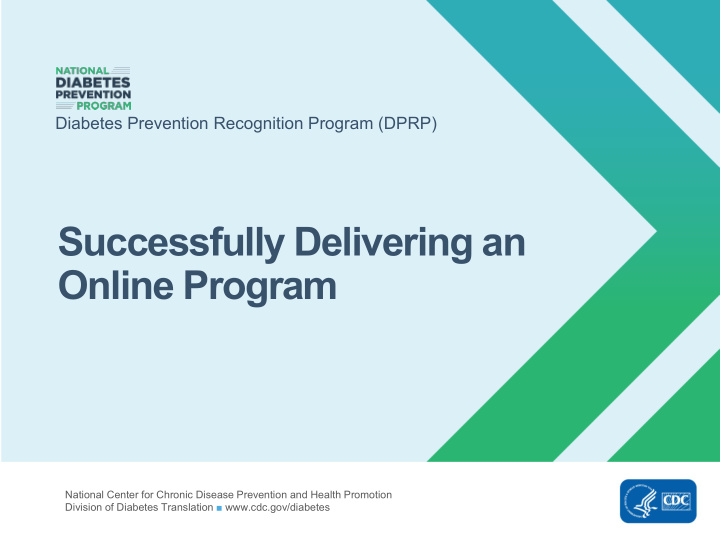



Diabetes Prevention Recognition Program (DPRP) Successfully Delivering an Online Program National Center for Chronic Disease Prevention and Health Promotion Division of Diabetes Translation ■ www.cdc.gov/diabetes
2 Delivery Modes In person Online Distance learning Combination
3 What does it mean to deliver an online program?
4 Online Delivery Yearlong lifestyle change program delivered 100% online for all participants (meaning participants log into course sessions via a computer, laptop, tablet, or smart phone). Participants also must interact with trained Lifestyle Coaches at various times and by various communication methods, including online classes, emails, phone calls, or texts.
5 Offering Multiple Delivery Modes All organizations must submit a separate application for each delivery mode they want to use. ▪ Classes cannot begin until the application is approved. ▪ All organizations, regardless of delivery mode, must adhere to the Diabetes Prevention Recognition Program (DPRP) Standards.
6 Capacity Assessment
7 Capacity to Deliver an Online Program Does your organization have an appropriate technology platform to: ▪ Deliver the online version of the yearlong lifestyle change program? ▪ Allow participants to interact with a Lifestyle Coach over the yearlong lifestyle change program? Have you provided training for program staff on the specific technology platform to be used to deliver the online lifestyle change program? Does your organization have the ability to obtain weights via digital technology such as Bluetooth-enabled scales?
8 Capacity to Deliver Online Program Does your organization have staff with the knowledge, skills, and tools needed to collect, enter, and submit the required evaluation data elements using a comma separated value (CSV) format to the CDC DPRP every 6 months? Does your organization have the capacity to manage large numbers of session records that could result from conducting an online program?
9 Session Delivery
10 Online Program Delivery Core Phase: ▪ 16 sessions, delivered approximately once per week during months 1–6, is the minimum requirement. ▪ Weekly sessions cannot be held more frequently than once per week. ▸ Guidance: Regular sessions should not be held more frequently than once every 5 days. Core Maintenance Phase: ▪ 6 sessions, delivered approximately once per month during months 7–12, is the minimum requirement. ▪ Monthly sessions cannot be held less frequently than once per month. ▸ Guidance: Regular sessions should not be held more than 35 days apart.
11 Lifestyle Coach Interaction Regular live interaction is required. ▪ In person ▪ Telephone ▪ Teleconference (for example, Skype or FaceTime) Coach interaction does not have to be 1:1. Text/emails do not count as live interaction.
12 Recording Attendance A session is comprised of working through the module, recording body weight, and recording physical activity minutes for the week leading up to starting the module. ▪ Dates cannot be recorded when a participant only weighs himself/herself and does not complete a module. ▪ Text/email reminders or communications with Lifestyle Coaches cannot be recorded on the spreadsheet. Only one date can be recorded per module completed. ▪ Multiple log-ins are allowed for the completion of a single module, but only one date can be recorded. ▪ CDC recommends recording the date of session completion rather than the date of the initial log-in.
13 Holding Extra Sessions Only sessions where a CDC-approved curriculum module is fully delivered can be recorded on the submission spreadsheet: ▪ Months 1-6, after offering the 16 required weekly core sessions ▸ May repeat core modules ▸ May use core maintenance modules (must be recorded as “C” on the spreadsheet) ▪ Months 7-12, after offering the required 6 core maintenance modules ▸ May offer additional core maintenance modules ▸ May repeat a core module (must be recorded as “CM” on the spreadsheet) Sessions that use unapproved supplemental materials or activities, or otherwise do not represent the completion of a full curriculum module, cannot be recorded on the submission spreadsheet.
14 Recording Weight and Physical Activity Minutes
15 Recording Weight Online participants are required to record their body weight at every session. Online programs should follow the guidance given in Appendix F of the 2018 DPRP Standards that pertains to all organizations. Online programs using Bluetooth-enabled scales must be able to ensure that the weight being recorded is the weight of the participant. ▪ We do not allow algorithms to be used to determine participant weight. Online programs using Bluetooth-enabled scales should record only one weight per session date. ▪ The closest weight to the recorded session date is the one to be used for each participant. ▪ The lowest weight taken during the weekly or monthly session can also be used as long as only one weight is recorded per session date.
16 Recording Physical Activity (PA) Minutes Online participants are required to track physical activity minutes once physical activity monitoring has begun in the curriculum. Consider how you will collect the minutes recorded by participants. ▪ Access the participant’s tracker of PA minutes. ▪ Use an online survey tool to submit PA minutes. ▪ Send an email request for participant’s weekly PA minutes. Physical activity minutes should reflect the total number of minutes accumulated during the week prior to starting the session. If participants have not yet been asked to report physical activity minutes, 999 should be recorded. If a participant reports doing no activity during the preceding week, then zero (0) minutes should be recorded.
Thank you for participating in the DPRP Visit the National DPP Customer Service Center at NationalDPPCSC.cdc.gov for more resources and to submit any questions you may have.
Recommend
More recommend